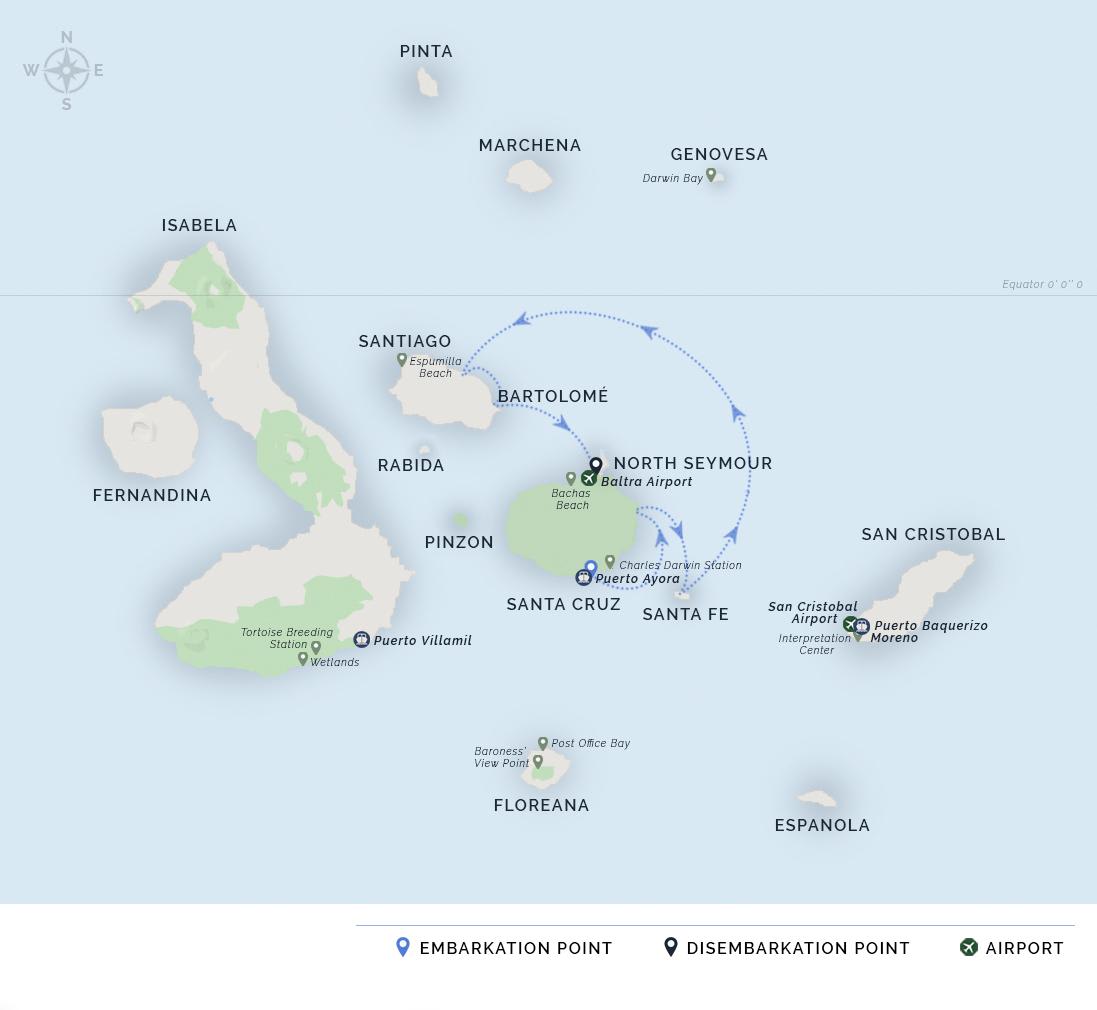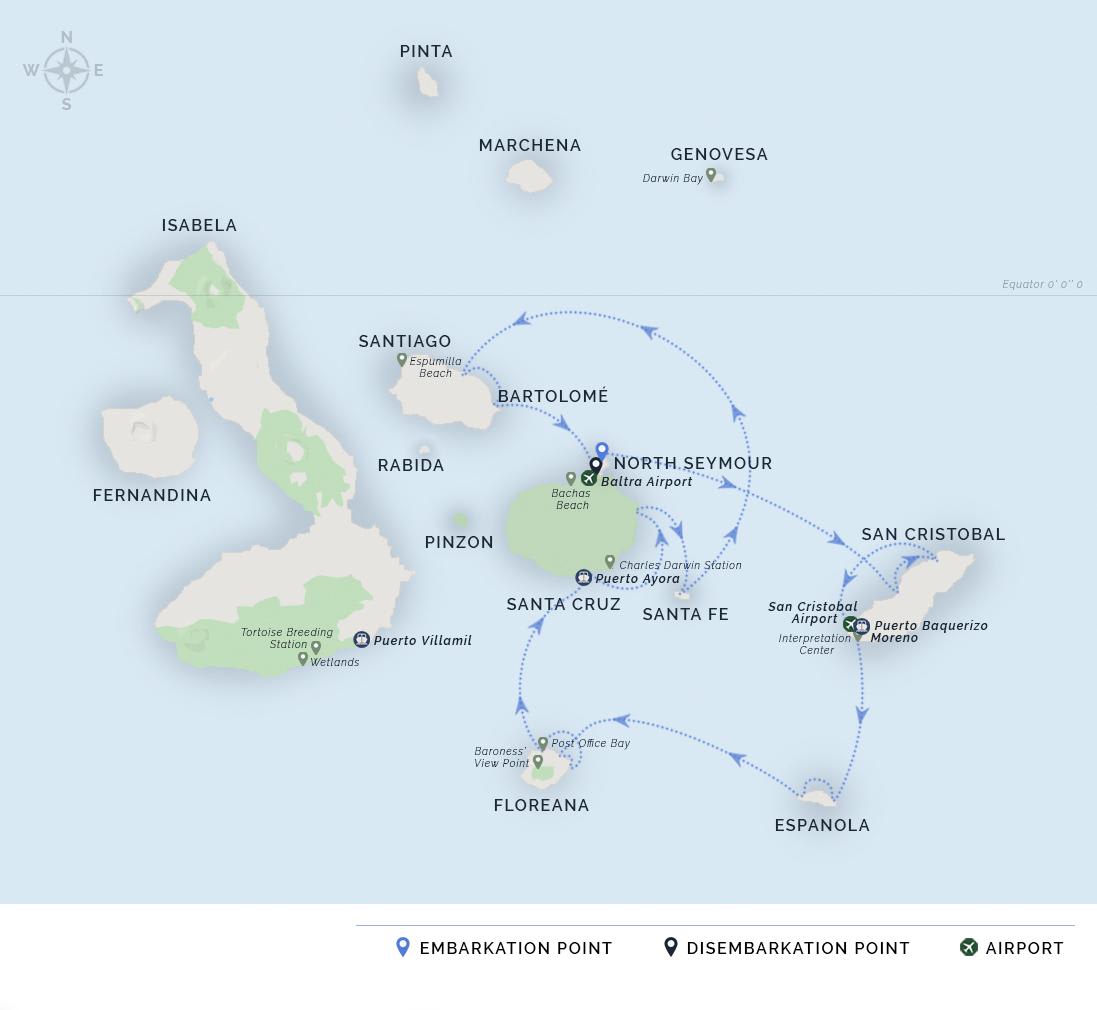Overview
Are you looking for a Galapagos cruise that combines comfort, stability, and adventure? The Nemo III offers all of that and more. With the sails unfurled, this 75–foot twin-hulled catamaran glides smoothly through the waters of the Galapagos Islands with up to 16 passengers aboard.
Life aboard a Galapagos Nemo III cruise
Your time aboard the Nemo III will be an authentic sailing experience, with comfortable single and double cabins. The boat also offers several social areas, perfect for getting to know your fellow guests and the six crew members. Throughout your cruise, enjoy three catered meals, plus snacks, created from local recipes and fresh ingredients each day.
Between meals, unwind with a soak in the Jacuzzi, which is located on the main deck. When you are ready for a break from the sun, retreat to the airconditioned interior, where a lounge full of cozy seating invites you to settle in and share stories of the day’s adventures. Whatever space you are in, the Nemo III invites you to make yourself at home, so prop your feet up, ask the ship’s barman for a sundowner and savor the moment.
Excursions from your Nemo III Galapagos cruise
Though the Nemo III may tempt you to relax onboard all day, you are likely traveling to Galapagos Islands to meet the area’s famed wildlife. Northern and southern routes through the islands, with options for four-, five, and eight-day cruises, feature plentiful opportunities to snorkel, hike, birdwatch, and kayak while searching for the native and endemic species that call the islands home.
Create the story of a lifetime by snorkeling with sea lions and fur seals during a stop at Santiago Island. Deepwater snorkeling at Gardner Bay on Española Island offers a rare chance to see sea turtles and rays. Keep your camera close at hand during a visit to Santa Cruz Island because you will not want to miss an opportunity to snap a photo of the giant tortoises.
Exemplary service aboard your Nemo III Galapagos Cruise
The Nemo III sailing vessel’s team is comprised of industry veterans with the know-how and experience to create safe, enjoyable, and engaging cruises. Though the Nemo III may seem at first glance to be less opulent than a luxury yacht, the friendly and welcoming staff go the extra mile to ensure you have the trip of a lifetime. Along the way, you will be escorted by a professional, English-speaking naturist guide who will provide expert knowledge on the wildlife and history of the region.
From young first-time sailors to retirees excited for the next adventure, cruisers of all ages will find much to love aboard the Nemo III. The availability of single beds is especially enticing to solo travelers hoping to meet new people while exploring the Galapagos Islands.
Itineraries & Prices
All itineraries are subject to change due to seasonal weather conditions (and resultant variations in river and tributary water levels) affecting accessibility to locations. Thus navigation routes, times and excursions may need to be modified at the cruise captain’s or your guide's discretion.
Embarkation
AM: Arrival at the airport in Baltra, reception by the cruise guide, and transfer to the yacht.
PM: Welcome cocktail. Lunch service and navigation to Bachas Beach in Santa Cruz. Wet landing for snorkeling. Bachas is “Spanglish” for 'barges' that were wrecked offshore during World War II. A common first landing site, there is a delightful swimming beach here, with a lagoon behind, and a longer beach for a stroll and wildlife watching. The saltwater lagoon behind often has great blue herons and small waders such as sanderlings and semi‐palmated plovers. Both beaches are nesting areas for green sea turtles, which leave tracks in the sand to the back of the beach, especially from November to February. The beach offers ample space for one to explore at leisure. Enjoy a guide briefing this evening as dinner is served and we navigate to Genovesa Island.

Prince Phillip's Steps & Darwin Bay
AM: Also known as the bird island. El Barranco, this is a demanding walk up a cliff, where tropicbirds, red-footed boobies, and other nesting seabirds can be found. We follow the trail through Palo Santo forest to a storm petrel colony passing red boobies and great Frigatebirds along the way.
PM: Darwin Bay is the caldera of a collapsed volcano. We land on a small coral beach, where will take an easy walk. For those looking for a little more action, there is a demanding optional walk over lava rock.
This path will uncover stunning views from the cliffs with ample time and opportunity to photograph the amazing birdlife. You may observe such species as swallow-tailed gulls, red-footed boobies, Nazca boobies, large ground finches, large cactus finches, sharp-billed ground finches, small marine iguanas, and Great Frigatebirds. Guide briefing and farewell cocktail. Dinner service and navigation to Santiago Island.

Sullivan Bay & Dragon Hill
AM: The main attraction of this bay are the broad, Pahoehoe, or rope lava flows. It is one of the most incredible places to compare the lava flows and their characteristics. Panga boat ride to Sullivan Bay. Nature walk. Snorkeling from the beach.
PM: Lunch service and navigation to Santa Cruz to visit Dragon Hill for a nature walk and deepwater snorkeling. Cerro Dragon, situated in the northwestern part of Santa Cruz Island, is named after the fact that in 1975, it was one of the only sites on this island, where land iguanas were found in a healthy state.
The iguanas were studied and then transported to a place specifically designed for breeding these animals in captivity. Luckily this measure allowed them to be saved from wild dogs and other domestic animals that have gone feral. In 1979 the first specimens were born and the populations were transported to the island of Venice. In the lagoons, there are shrimp, which serve as food for flamingos; at certain times of the year the shrimp is more abundant and therefore the population of these birds is larger. This evening we will have a guide briefing and dinner service.

Disembarkation
AM: In the morning, explore the highlands of Santa Cruz which have incredible zones of vegetation. Visit the private estate “Las Primicias”. This reserve offers you one of the best possibilities to see the huge turtles of Santa Cruz Island in their natural habitat. You can observe them from very close. After your morning excursion, you will be assisted to Baltra airport for your flight to the mainland.

Embarkation
AM: Arrival at the airport in Baltra, reception with the cruise guide, and transfer to the yacht.
PM: Lunch service. Visit Charles Darwin Scientific Station and Breeding Center. The main visit to Puerto Ayora is to Charles Darwin Station. An excellent way to begin learning about the islands, their origin, and their formation. You will learn about how the Galapagos turtles are raised and meet George, the famous solitary turtle. The Scientific Station has a beach that receives many visitors on weekends. Dinner is served as we navigate to South Plaza.

South Plaza & Santa Fe
AM: Breakfast service followed by a visit to South Plaza. The rocky trail circumnavigates the island displaying the combination of dry and coastal vegetation zone. South Plaza has one of the largest populations of Land Iguanas in the Galapagos. The iguanas seem to be everywhere once you land. These larger than average yellow‐brown land iguanas feed on the fruit and pads of the prickly pear cactus. South Plaza is also home to Marine Iguanas living along the coast and a Hybrid Iguanas whose fathers are Marine Iguanas and mothers are Land Iguanas.
PM: Lunch service. Navigation to Santa Fe. Santa Fe was formed from an uplift (rather than a volcano) giving the island a relatively flat surface rather than the typical conical shape of the other islands. Visits to Santa Fe begin with a panga boat ride across the lovely turquoise lagoon. Once ashore you are brought into contact with one of the many sea lion colonies in the Galapagos. Bulls compete for the right of beach master while cows lounge in the sun. This evening dinner will be served as we navigate to San Cristobal.

Bartolome & Chinese Hat
PM: Breakfast service. Deepwater snorkeling. Visit Bartolome. Dry landing. Nature walk. This desolate island with few plants is the most visited and most photographed island in the Galapagos. The island consists of an extinct volcano and a variety of red, orange, green, and glistening black volcanic formations. The best known of the island's features is the Tuff Cone known as Pinnacle Rock. This large black partially eroded lava formation was created when magma expelled from the volcano reached the sea. When the seawaters cooled the hot lava it caused an explosion. The exploded particles eventually fasten together forming a rock composed of thin layers.
Lying beside Pinnacle Rock are twin half-moon-shaped beaches. The northern beach is a popular snorkeling site where visitors have the opportunity to swim with fish, Sea Lions and Galapagos Penguins. Much larger animals can be found near the southern beach including stingrays, spotted eagle rays, white‐tipped sharks, and black‐tipped sharks. Little vegetation grows in this barren place. Mangroves border the beach and the small shrub Tiguilia grows in the volcanic sands. The seeds and tiny white flowers of the Chamaesycae provide food for the island's finch. These plants are common to arid regions and can survive in these harsh volcanic conditions.
PM: Lunch service. Visit Santiago Island. Wet landing at Chinese Hat. Nature walk. Deepwater snorkeling. Visit Chinese Hat, a tiny island just off the southeast tip of Santiago. Its name describes the island's shape. The landing is on a beautiful crescent‐shaped white sand beach, home to Sea Lions and Sally Lightfoot Crabs. The trail on Sombrero Chino's explores its volcanic origin, one of the most evident in the islands.
The lava rock is very fragile and tends to break off when people walk over it. The sharp outcroppings caused by these breaks make it necessary to wear good walking shoes. Patches of Pahoehoe Lava cracked lava and lava tubes can be found on the island. While the path does not lead up the striking red rust sides of the Chinese Hat to the caldera, it does venture high enough on the island to offer some spectacular views of the waves crashing below. Snorkeling in the waters near Chinese Hat can create a stir; white‐tipped sharks frequent the area, as do the playful Galapagos Penguins and Sea Lions. Enjoy dinner service and a farewell cocktail.

Disembarkation
AM: Visit to Mosquera Islet. Wet landing. Breakfast service. The Mosquera Islet is located between the islands of Baltra and North Seymour. It is a reef of rocks and coral (the result of an uprising) and a great white sand beach. Its narrowest width reaches about 160 meters and has an estimated length of 600 meters. In most of the perimeter there is base of lava rocks, as evidence of the lava uprising, except in the southwest side where the landing occurs. This island has one of the largest populations of sea lions. You can also observe several species of shorebirds. There have been occasional reports at this site of Orcas (Orcinus orca) feeding on sea lions. Check out and airport departure at 8:00.

Embarkation
AM: Arrival at the airport in Baltra, reception by the cruise guide, and transfer to the yacht.
PM: Lunch service. Visit Charles Darwin Scientific Station and Breeding Center. The main visit to Puerto Ayora is to Charles Darwin Station. An excellent way to begin learning about the islands, their origin, and their formation. You will learn about how the Galapagos turtles are raised and meet Jorge, the famous solitary turtle. The Scientific Station has its own beach that receives many visitors on weekends. Guide briefing. Dinner service and navigation to Isabela Island.

Moreno Point & Urbina Bay
AM: Breakfast service. Visit Moreno Point - a place where the forces of the Galapagos have joined to create a work of art. The tour starts with a panga boat ride along the beautiful rocky shores where Galapagos Penguins and shorebirds are frequently seen. After a dry landing, the path traverses through jagged black lava rock. As the swirling black lava flow gave way to form craters, crystal tide pools formed-some surrounded by mangroves. This is a magnet for small blue lagoons, pink flamingos, blue herons, and Bahamas’ pintail ducks. Brown pelicans can be seen nesting in the green leaves of the mangroves. You can walk to the edge of the lava to look straight down on these pools including the occasional green sea turtle, white-tipped shark, and pufferfish. This idyllic setting has suffered from the presence of introduced species. Feral dogs in the area are known to attack sea lions and marine iguanas.
PM: Lunch service and navigation to Urbina Bay. Wet landing. Nature walk and more wildlife watching. Shallow-water snorkeling. Lying at the foot of Alcedo Volcano, south of Tagus Cove, is Urbina Bay, one of the best and the most recent example of geological uplift in the Galapagos. Uplifts occur when the molten materials beneath the surface shift. In 1954 the shoreline was uplifted by nearly 15 feet (4 meters). The coastline was driven 3/4 of a mile further out to sea, exposing giant coral heads and stranding marine organisms on what was now onshore. A Disney film crew visited the site shortly afterward and discovered skeletons of sharks, sea turtles, and lobsters unable to find the ocean from the rapidly rising land. Schools of fish were found stranded in newly formed tide pools. Boulder-sized coral heads can be seen near the area that once was the beach. The uplifting of Urbina Bay was followed by an eruption of Alcedo a few weeks later.
Seasonally Urbina Bay provides a nesting area for many of the Galapagos creatures. Female tortoises journey down from Alcedo to lay their eggs in the sand. Galapagos penguins, flightless cormorants, and brown pelicans nest in the area as well. The visit begins with a wet landing on the white sand beach. The difficulty of the route varies by season. The trail ranges from stark and easily passable during the dry season to mildly challenging requiring wading to pass during the rainy season. Visitors cross the uplifted region learning about this geological wonder. Then reach the sandy area that was once the beach. Shorter visits return to the landing point on the same path, while longer visits continue past the coral heads and new beach. Other highlights of this site include marine iguanas and some of the largest land iguanas in the islands, and Galapagos Cotton an endemic plant, historians believe the Incas brought to the islands, while naturalists theorize it floated across from Peru. Guide briefing. Dinner service and navigation to Fernandina Island.

Espinoza Point & Tagus Cove
AM: Breakfast service. Visit to Fernandina Island. Wet landing. Nature walk on Espinoza Point. Deep water snorkeling. Fernandina Island is the youngest and most active volcano in the Galapagos, with eruptions taking place every few years. The flat lava of Punta Espinosa offers a stark and barren landscape, but here flightless cormorants build their nests on the point, sea lions sprawl on the beach or play in the tide pools and large numbers of marine iguanas dot the sand. We also will have the opportunity to compare the Aa and Pahoehoe lava types here.
PM: Lunch service and navigation to Isabela Island. Visit to Tagus Cove. Dry landing. Nature walk. Panga boat ride. Deep water snorkeling. Tagus cove (Isabela Island) is situated directly east of Fernandina Island on the west coast of Isabela Island. It is a beautiful, well-protected cove sheltered by the shoulders of two volcanic craters and has been used as an anchorage for over 300 years. A nature trail here ascends through the typical dry vegetation zone and offers spectacular views of Darwin Lake, a saltwater crater lake and the long narrow inlet that appears to connect with it. At the top of the trail it is possible to observe the different vegetation zones, catch a glimpse of Darwin and Wolf volcanoes, and observe Galapagos Penguins, Flightless Cormorants and Pelicans. Guide briefing. Dinner service and navigation to Santiago Island.

Puerto Egas & Buccaneer's Cove
AM: Breakfast service. Wet landing. Visit Puerto Egas: nature walk, salt mines, and fur seal grotto. Shallow-water snorkeling. A visit to Puerto Egas begins with a wet landing on the dark sand beaches of James Bay. Taking a walk along the rocky coast offers visitors the opportunity to view some of Galapagos Island's best tide pools. Sponges, snails, hermit crabs, barnacles, and fish including the endemic four-eyed blenny can be seen. The walk also presents visitors with a variety of shorebirds, marine iguanas, sally lightfoot crabs, and sea lions. Finally reaching the crater rim presents an incredible vista. Looking into the crater you can see this extinct volcano whose floor has sunken below sea level. Saltwater seeps into the crater creating a small salt lake. The sun evaporates the water, leaving the salt that many have tried to mine without success.
Looking away from the crater are the older orange lava fields supporting vegetation including the Palo Santo trees and the younger desolate black lava fields. The second excursion begins just a short distance beyond the tide pools and heads to the fur seal grotto. Fur seals and sea lions can be seen swimming in the rocky lava-ringed pools. This may be the only opportunity visitors have to see and swim with fur seals.
PM: Lunch service. Panga boat ride to Buccaneer ́s Cove. Deepwater snorkeling. Less than an hour north of Puerto Egas, Buccaneers Cove served as a haven for pirates, sailors, and whalers during the 18th and 19th centuries. Anchoring in the protected bay they were able to make much-needed repairs to their ships while other men went ashore to stock up on salt, tortoises, fresh water, and firewood. Several years ago ceramic jars were found at the bottom of the bay, the disregarded cargo of some mariner from years ago. Inside the jars were supplies of wine and marmalade.
Few boats stop at Buccaneers Cove today. Though many cruises by at a slow speed allowing visitors to view the cliffs made of tuff formations and the dark reddish-purple sand beach. This dramatic landscape is made all the more impressive by the hundreds of seabirds perched atop the cliffs. Two of the more recognizable rock formations are known as the "monk" and "elephant rock". A large population of feral goats now frequents Buccaneers Cove and this portion of Santiago. The National Park Service has fenced off part of the area to protect the native vegetation from the destructive eating habits of this introduced species. A wet landing on the large coffee-colored sand beach is just north of the prized freshwater supply that once attracted pirates and whalers. Guide briefing. Farewell cocktail. Dinner service and navigation to Daphne Island.

Disembarkation
AM: Breakfast service. Among the central islands of the Galapagos Archipelago, Daphne Island sits north of Santa Cruz Island and west of Baltra Island. In reality there are two islands: Daphne Major and Daphne Minor. They are one of the more accessible Galapagos Islands and are easily reached by most tour boats and cruises. Please note that disembarkation on these islands is not possible, therefore we will sail around them for one last look at the beautiful vistas of Galapagos. Check out and airport departure at 8:00.
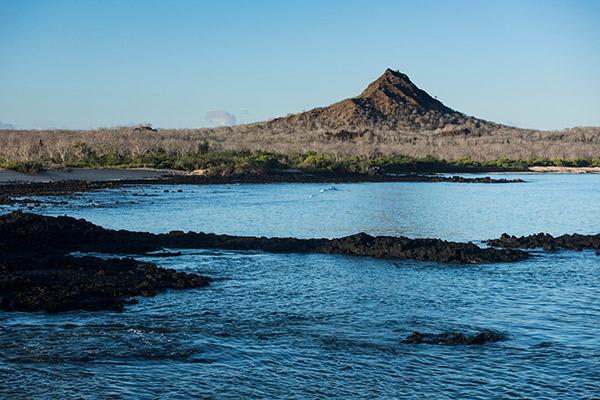
Embarkation
AM: Arrival at the airport in Baltra, reception by the cruise guide, and transfer to the yacht.
PM: Lunch service and navigation to Seymour Island, North of Baltra. Dry landing. A nature walk in North Seymour. The trail is approximately 2 km (1.25 miles) in length crossing the inland of the island and exploring the rocky coast. Along the way, the trail passes colonies of Blue-Footed Boobies and Magnificent Frigatebirds. The Magnificent Frigatebird, a large black bird with a long wingspan, and a hooked beak is extremely fast and has excellent vision. Frigatebirds are known for the large red pouch on their necks. Boobies and Frigates share an interesting relationship. Sharing the same nesting area on North Seymour Blue-Footed Boobies nest on the ground making their nests from the twigs of the Palo Santos Trees, while the Magnificent Frigatebird nests just above them in the saltbushes. Guide briefing. Welcome cocktail. Dinner service and navigation to San Cristobal Island.

Kicker Rock & Brujo Hill
AM: Breakfast service. Dry landing. Nature walk and more wildlife watching. Deepwater snorkeling. Lobos Island, as its name suggests is famous for its population of sea lions and fur sea lions. You will also encounter nesting grounds for the great Frigatebird and a small number of blue-footed boobies. Breeding center, there will be explained, in a simple manner, the natural phenomena that created the Galapagos Islands. That is the geology and the series of natural processes, such as volcanic eruption and marine current locations that have led to the amazing islands that you are now visiting.
PM: Lunch service and navigation to Cerro Brujo. Panga boat exploration rides. Wet landing. Nature walk. Deepwater snorkeling. One of the first sites visited by Charles Darwin, Cerro Brujo is a beautiful white sand beach where Brown Pelicans, Blue‐Footed Boobies, sea lions, and marine iguanas are all found. An onshore version of nearby Kicker Rock, Cerro Brujo is a very striking, eroded tuff cone. There is no landing at Kicker Rock. Also known as “León Dormido” these rocks are located off the coast of San Cristobal. It is the remains of a lava cone eroded by the sea, the two vertical rocks rising 500 feet from the ocean form a small channel that is navigable by small boats. This natural monument has become a favorite sight for cruises due to the many Tropicbirds, Frigates, and Boobies that fill the surrounding air. Beneath the sea, the nearly crystal waters offer a brilliant show of colorful tropical fish and invertebrates. Guide briefing. Dinner service and navigation to Espanola Island.

Gardner Bay & Suarez Point
AM: Breakfast service. Deepwater snorkeling. Panga boat exploration rides to Gardner Bay. Dry landing. Gardner Islet, Osborn Islet. Nature walk. Swimming. Gardner Bay is a 45‐minute boat ride from Suarez Point. It has a white sand beach and there is a small colony of sea lions. The possibilities for swimming or scuba diving are excellent here. Visitors find migrant, resident, and endemic wildlife including brightly colored Marine Iguanas, Española Lava Lizards, Hood Mockingbirds, Swallow-Tailed Gulls, Blue Footed and Masked Boobies, Galapagos Hawks, a selection of Finch, and the Waved Albatross. Snorkel and go on a panga ride at Gardner Islet, and at Osborn Islet snorkel once more.
PM: Lunch service. Visit Suarez Point. Dry landing. Nature walk. Suarez point is located on the western tip of Española and it offers great wildlife viewing of such species as Sea Lions, Sea Birds, and the largest Marine Iguanas of Galapagos. This is one of the best sites in the Galapagos. The amount of wildlife is overwhelming. Along the beach, there are many Sea Lions and large, colorful Lava Lizards, and Marine Iguanas. As you follow the trail to the cliff's edge Masked Boobies can be found nesting among the rock formations. After a short walk down to a beach and back up the other side, Blue‐Footed Boobies are seen nesting just off the trail. Guide briefing. Dinner service and navigation to Floreana Island.

Cormorant Point, Champion Islet & Post Office Bay
AM: Breakfast service. Visit to Floreana Island: Cormorant Point, Champion Islet, Baroness Viewpoint. Wet landing. Nature walk*. Possible activities: deep water snorkeling, kayaking, panga boat exploration rides. The visit to Cormorant Point offers two contrasting beaches. Arriving on shore you will encounter a green sand beach (the green sand is caused by the olivine crystals derived silicates or magnesium and iron). From here you will follow the trail leading to a lagoon where Pink Flamingoes and other shore birds can be seen in the distance making their home. If you look closely at the mud of this lagoon, there appears to be 'cracks' in the mud. These cracks are not caused from dryness but are actual flamingo footpaths.
This is also a good spot for seeing Large‐Billed Flycatchers, Small‐Ground Finches, Medium‐Ground Finches or Cactus Finches. The walk continues to another beach on the other side made of fine white sand particles known as "Flour Beach". In the waters Ghost Crabs and Rays can be seen swimming. Time and weather permitting you may even go for a swim or a snorkel. Other activities include a panga ride to Champion Point and kayaking at Baroness Viewpoint.
PM: Lunch service. Panga boat ride to Post Office Bay. Wet landing. Nature walk. Snorkeling from the beach. In 1793 British whalers established the Post Office Barrel to send letters to and from England. This tradition has continued over the years, and even today visitors may drop off and pick up letters, without stamps, to be carried to far destinations. This is one of the few visitor sites that is visited for its human history. Outbound ships would drop off letters after rounding the cape and the ships returning home would mail them. Over the years thousands of ships have stopped to send and receive mail at Post Office Bay. Many have posted a sign of driftwood or other materials memorializing their visit. This is the only area in the Galapagos were graffiti is still acceptable.
Arriving at Post Office Bay you will land on a brown sand beach, passing the sea lions lying in the sun. At the post barrel the guide will pull a handful of letters for the group. Continuing the tradition, the letters are brought home with the traveler and then mailed to the addressee. Visitors also have the opportunity to send letters of their own. There are also the remains of a Norwegian Fishing Village a commercial fishing operation established in 1926 and abandoned a couple of years later. The group of Norwegians arrived with dreams of riches started a fishing and canning operation on $900 each. The tough Galapagos life and a few misfortunes had them abandon their dreams. Time and weather permitting you may have the opportunity to snorkel again from the beach. Guide briefing. Dinner service and navigation to Santa Cruz Island.

Disembarkation
AM: In the morning, explore the highlands of Santa Cruz which have incredible zones of vegetation. Visit the private estate “Las Primicias”. This reserve offers you one of the best possibilities to see the huge turtles of Santa Cruz Island in their natural habitat. You can observe them from very close. After your morning excursion, you will be assisted to Baltra airport for your flight to the mainland.

Embarkation
AM: Arrival at the airport in Baltra, reception by the cruise guide, and transfer to the yacht.
PM: Welcome cocktail. Lunch service and navigation to Bachas Beach in Santa Cruz. Wet landing for snorkeling. Bachas is “Spanglish” for 'barges' that were wrecked offshore during World War II. A common first landing site, there is a delightful swimming beach here, with a lagoon behind, and a longer beach for a stroll and wildlife watching. The saltwater lagoon behind often has great blue herons and small waders such as sanderlings and semi‐palmated plovers. Both beaches are nesting areas for green sea turtles, which leave tracks in the sand to the back of the beach, especially from November to February. The beach offers ample space for one to explore at leisure. Enjoy a guide briefing this evening as dinner is served and we navigate to Genovesa Island.

Prince Phillip's Steps & Darwin Bay
AM: Also known as the bird island. El Barranco, this is a demanding walk up a cliff, where tropicbirds, red-footed boobies, and other nesting seabirds can be found. We follow the trail through Palo Santo forest to a storm petrel colony passing red boobies and great Frigatebirds along the way.
PM: Darwin Bay is the caldera of a collapsed volcano. We land on a small coral beach, where will take an easy walk. For those looking for a little more action, there is a demanding optional walk over lava rock.
This path will uncover stunning views from the cliffs with ample time and opportunity to photograph the amazing birdlife. You may observe such species as swallow-tailed gulls, red-footed boobies, Nazca boobies, large ground finches, large cactus finches, sharp-billed ground finches, small marine iguanas, and Great Frigatebirds. Guide briefing and farewell cocktail. Dinner service and navigation to Santiago Island.

Sullivan Bay & Dragon Hill
AM: The main attraction of this bay are the broad, Pahoehoe, or rope lava flows. It is one of the most incredible places to compare the lava flows and their characteristics. Panga boat ride to Sullivan Bay. Nature walk. Snorkeling from the beach.
PM: Lunch service and navigation to Santa Cruz to visit Dragon Hill for a nature walk and deepwater snorkeling. Cerro Dragon, situated in the northwestern part of Santa Cruz Island, is named after the fact that in 1975, it was one of the only sites on this island, where land iguanas were found in a healthy state.
The iguanas were studied and then transported to a place specifically designed for breeding these animals in captivity. Luckily this measure allowed them to be saved from wild dogs and other domestic animals that have gone feral. In 1979 the first specimens were born and the populations were transported to the island of Venice. In the lagoons, there are shrimp, which serve as food for flamingos; at certain times of the year the shrimp is more abundant and therefore the population of these birds is larger. This evening we will have a guide briefing and dinner service.

Highlands & Charles Darwin Station
AM: Breakfast service. Visit to Santa Cruz Highlands. Dry landing. The highlands of Santa Cruz have incredible zones of vegetation. Visit to the private estate “Las Primicias”. This reserve offers you one of the best possibilities to see the huge turtles of Santa Cruz Island in their natural habitat. You can observe them from very close.
PM: Lunch service. Visit to Charles Darwin Scientific Station and Breeding Center. Dry landing. The main visit in Puerto Ayora is to Charles Darwin Station. An excellent way to begin learning about the islands, their origin and formation. You will learn about how the Galapagos turtles are raised and meet Jorge, the famous solitary turtle. The Scientific Station has its own beach that receives many visitors on weekends. Guide briefing. Dinner service and navigation to Isabela Island.

Moreno Point & Urbina Bay
AM: Breakfast service. Visit Moreno Point - a place where the forces of the Galapagos have joined to create a work of art. The tour starts with a panga boat ride along the beautiful rocky shores where Galapagos Penguins and shorebirds are frequently seen. After a dry landing, the path traverses through jagged black lava rock. As the swirling black lava flow gave way to form craters, crystal tide pools formed-some surrounded by mangroves. This is a magnet for small blue lagoons, pink flamingos, blue herons, and Bahamas’ pintail ducks. Brown pelicans can be seen nesting in the green leaves of the mangroves. You can walk to the edge of the lava to look straight down on these pools including the occasional green sea turtle, white-tipped shark, and pufferfish. This idyllic setting has suffered from the presence of introduced species. Feral dogs in the area are known to attack sea lions and marine iguanas.
PM: Lunch service and navigation to Urbina Bay. Wet landing. Nature walk and more wildlife watching. Shallow-water snorkeling. Lying at the foot of Alcedo Volcano, south of Tagus Cove, is Urbina Bay, one of the best and the most recent example of geological uplift in the Galapagos. Uplifts occur when the molten materials beneath the surface shift. In 1954 the shoreline was uplifted by nearly 15 feet (4 meters). The coastline was driven 3/4 of a mile further out to sea, exposing giant coral heads and stranding marine organisms on what was now onshore. A Disney film crew visited the site shortly afterward and discovered skeletons of sharks, sea turtles, and lobsters unable to find the ocean from the rapidly rising land. Schools of fish were found stranded in newly formed tide pools. Boulder-sized coral heads can be seen near the area that once was the beach. The uplifting of Urbina Bay was followed by an eruption of Alcedo a few weeks later.
Seasonally Urbina Bay provides a nesting area for many of the Galapagos creatures. Female tortoises journey down from Alcedo to lay their eggs in the sand. Galapagos penguins, flightless cormorants, and brown pelicans nest in the area as well. The visit begins with a wet landing on the white sand beach. The difficulty of the route varies by season. The trail ranges from stark and easily passable during the dry season to mildly challenging requiring wading to pass during the rainy season. Visitors cross the uplifted region learning about this geological wonder. Then reach the sandy area that was once the beach. Shorter visits return to the landing point on the same path, while longer visits continue past the coral heads and new beach. Other highlights of this site include marine iguanas and some of the largest land iguanas in the islands, and Galapagos Cotton an endemic plant, historians believe the Incas brought to the islands, while naturalists theorize it floated across from Peru. Guide briefing. Dinner service and navigation to Fernandina Island.

Espinoza Point & Tagus Cove
AM: Breakfast service. Visit to Fernandina Island. Wet landing. Nature walk on Espinoza Point. Deep water snorkeling. Fernandina Island is the youngest and most active volcano in the Galapagos, with eruptions taking place every few years. The flat lava of Punta Espinosa offers a stark and barren landscape, but here flightless cormorants build their nests on the point, sea lions sprawl on the beach or play in the tide pools and large numbers of marine iguanas dot the sand. We also will have the opportunity to compare the Aa and Pahoehoe lava types here.
PM: Lunch service and navigation to Isabela Island. Visit to Tagus Cove. Dry landing. Nature walk. Panga boat ride. Deep water snorkeling. Tagus cove (Isabela Island) is situated directly east of Fernandina Island on the west coast of Isabela Island. It is a beautiful, well-protected cove sheltered by the shoulders of two volcanic craters and has been used as an anchorage for over 300 years. A nature trail here ascends through the typical dry vegetation zone and offers spectacular views of Darwin Lake, a saltwater crater lake and the long narrow inlet that appears to connect with it. At the top of the trail it is possible to observe the different vegetation zones, catch a glimpse of Darwin and Wolf volcanoes, and observe Galapagos Penguins, Flightless Cormorants and Pelicans. Guide briefing. Dinner service and navigation to Santiago Island.

Puerto Egas & Buccaneer's Cove
AM: Breakfast service. Wet landing. Visit Puerto Egas: nature walk, salt mines, and fur seal grotto. Shallow-water snorkeling. A visit to Puerto Egas begins with a wet landing on the dark sand beaches of James Bay. Taking a walk along the rocky coast offers visitors the opportunity to view some of Galapagos Island's best tide pools. Sponges, snails, hermit crabs, barnacles, and fish including the endemic four-eyed blenny can be seen. The walk also presents visitors with a variety of shorebirds, marine iguanas, sally lightfoot crabs, and sea lions. Finally reaching the crater rim presents an incredible vista. Looking into the crater you can see this extinct volcano whose floor has sunken below sea level. Saltwater seeps into the crater creating a small salt lake. The sun evaporates the water, leaving the salt that many have tried to mine without success.
Looking away from the crater are the older orange lava fields supporting vegetation including the Palo Santo trees and the younger desolate black lava fields. The second excursion begins just a short distance beyond the tide pools and heads to the fur seal grotto. Fur seals and sea lions can be seen swimming in the rocky lava-ringed pools. This may be the only opportunity visitors have to see and swim with fur seals.
PM: Lunch service. Panga boat ride to Buccaneer ́s Cove. Deepwater snorkeling. Less than an hour north of Puerto Egas, Buccaneers Cove served as a haven for pirates, sailors, and whalers during the 18th and 19th centuries. Anchoring in the protected bay they were able to make much-needed repairs to their ships while other men went ashore to stock up on salt, tortoises, fresh water, and firewood. Several years ago ceramic jars were found at the bottom of the bay, the disregarded cargo of some mariner from years ago. Inside the jars were supplies of wine and marmalade.
Few boats stop at Buccaneers Cove today. Though many cruises by at a slow speed allowing visitors to view the cliffs made of tuff formations and the dark reddish-purple sand beach. This dramatic landscape is made all the more impressive by the hundreds of seabirds perched atop the cliffs. Two of the more recognizable rock formations are known as the "monk" and "elephant rock". A large population of feral goats now frequents Buccaneers Cove and this portion of Santiago. The National Park Service has fenced off part of the area to protect the native vegetation from the destructive eating habits of this introduced species. A wet landing on the large coffee-colored sand beach is just north of the prized freshwater supply that once attracted pirates and whalers. Guide briefing. Farewell cocktail. Dinner service and navigation to Daphne Island.
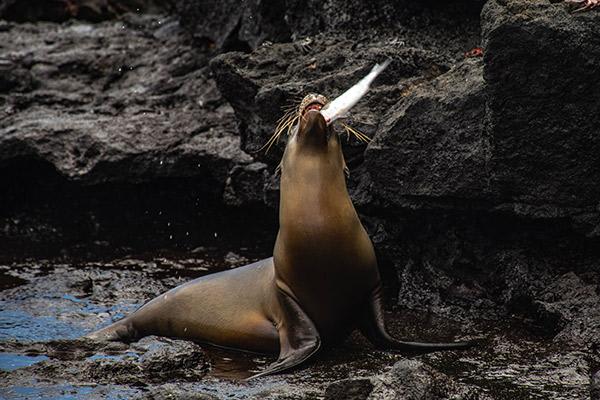
Disembarkation
AM: Breakfast service. Among the central islands of the Galapagos Archipelago, Daphne Island sits north of Santa Cruz Island and west of Baltra Island. In reality there are two islands: Daphne Major and Daphne Minor. They are one of the more accessible Galapagos Islands and are easily reached by most tour boats and cruises. Please note that disembarkation on these islands is not possible, therefore we will sail around them for one last look at the beautiful vistas of Galapagos. Check out and airport departure at 8:00.

Embarkation
AM: Arrival at the airport in Baltra, reception by the cruise guide, and transfer to the yacht.
PM: Lunch service and navigation to Seymour Island, North of Baltra. Dry landing. A nature walk in North Seymour. The trail is approximately 2 km (1.25 miles) in length crossing the inland of the island and exploring the rocky coast. Along the way, the trail passes colonies of Blue-Footed Boobies and Magnificent Frigatebirds. The Magnificent Frigatebird, a large black bird with a long wingspan, and a hooked beak is extremely fast and has excellent vision. Frigatebirds are known for the large red pouch on their necks. Boobies and Frigates share an interesting relationship. Sharing the same nesting area on North Seymour Blue-Footed Boobies nest on the ground making their nests from the twigs of the Palo Santos Trees, while the Magnificent Frigatebird nests just above them in the saltbushes. Guide briefing. Welcome cocktail. Dinner service and navigation to San Cristobal Island.

Kicker Rock & Brujo Hill
AM: Breakfast service. Dry landing. Nature walk and more wildlife watching. Deepwater snorkeling. Lobos Island, as its name suggests is famous for its population of sea lions and fur sea lions. You will also encounter nesting grounds for the great Frigatebird and a small number of blue-footed boobies. Breeding center, there will be explained, in a simple manner, the natural phenomena that created the Galapagos Islands. That is the geology and the series of natural processes, such as volcanic eruption and marine current locations that have led to the amazing islands that you are now visiting.
PM: Lunch service and navigation to Cerro Brujo. Panga boat exploration rides. Wet landing. Nature walk. Deepwater snorkeling. One of the first sites visited by Charles Darwin, Cerro Brujo is a beautiful white sand beach where Brown Pelicans, Blue‐Footed Boobies, sea lions, and marine iguanas are all found. An onshore version of nearby Kicker Rock, Cerro Brujo is a very striking, eroded tuff cone. There is no landing at Kicker Rock. Also known as “León Dormido” these rocks are located off the coast of San Cristobal. It is the remains of a lava cone eroded by the sea, the two vertical rocks rising 500 feet from the ocean form a small channel that is navigable by small boats. This natural monument has become a favorite sight for cruises due to the many Tropicbirds, Frigates, and Boobies that fill the surrounding air. Beneath the sea, the nearly crystal waters offer a brilliant show of colorful tropical fish and invertebrates. Guide briefing. Dinner service and navigation to Espanola Island.

Gardner Bay & Suarez Point
AM: Breakfast service. Deepwater snorkeling. Panga boat exploration rides to Gardner Bay. Dry landing. Gardner Islet, Osborn Islet. Nature walk. Swimming. Gardner Bay is a 45‐minute boat ride from Suarez Point. It has a white sand beach and there is a small colony of sea lions. The possibilities for swimming or scuba diving are excellent here. Visitors find migrant, resident, and endemic wildlife including brightly colored Marine Iguanas, Española Lava Lizards, Hood Mockingbirds, Swallow-Tailed Gulls, Blue Footed and Masked Boobies, Galapagos Hawks, a selection of Finch, and the Waved Albatross. Snorkel and go on a panga ride at Gardner Islet, and at Osborn Islet snorkel once more.
PM: Lunch service. Visit Suarez Point. Dry landing. Nature walk. Suarez point is located on the western tip of Española and it offers great wildlife viewing of such species as Sea Lions, Sea Birds, and the largest Marine Iguanas of Galapagos. This is one of the best sites in the Galapagos. The amount of wildlife is overwhelming. Along the beach, there are many Sea Lions and large, colorful Lava Lizards, and Marine Iguanas. As you follow the trail to the cliff's edge Masked Boobies can be found nesting among the rock formations. After a short walk down to a beach and back up the other side, Blue‐Footed Boobies are seen nesting just off the trail. Guide briefing. Dinner service and navigation to Floreana Island.

Cormorant Point, Champion Islet & Post Office Bay
AM: Breakfast service. Visit to Floreana Island: Cormorant Point, Champion Islet, Baroness Viewpoint. Wet landing. Nature walk*. Possible activities: deep water snorkeling, kayaking, panga boat exploration rides. The visit to Cormorant Point offers two contrasting beaches. Arriving on shore you will encounter a green sand beach (the green sand is caused by the olivine crystals derived silicates or magnesium and iron). From here you will follow the trail leading to a lagoon where Pink Flamingoes and other shore birds can be seen in the distance making their home. If you look closely at the mud of this lagoon, there appears to be 'cracks' in the mud. These cracks are not caused from dryness but are actual flamingo footpaths.
This is also a good spot for seeing Large‐Billed Flycatchers, Small‐Ground Finches, Medium‐Ground Finches or Cactus Finches. The walk continues to another beach on the other side made of fine white sand particles known as "Flour Beach". In the waters Ghost Crabs and Rays can be seen swimming. Time and weather permitting you may even go for a swim or a snorkel. Other activities include a panga ride to Champion Point and kayaking at Baroness Viewpoint.
PM: Lunch service. Panga boat ride to Post Office Bay. Wet landing. Nature walk. Snorkeling from the beach. In 1793 British whalers established the Post Office Barrel to send letters to and from England. This tradition has continued over the years, and even today visitors may drop off and pick up letters, without stamps, to be carried to far destinations. This is one of the few visitor sites that is visited for its human history. Outbound ships would drop off letters after rounding the cape and the ships returning home would mail them. Over the years thousands of ships have stopped to send and receive mail at Post Office Bay. Many have posted a sign of driftwood or other materials memorializing their visit. This is the only area in the Galapagos were graffiti is still acceptable.
Arriving at Post Office Bay you will land on a brown sand beach, passing the sea lions lying in the sun. At the post barrel the guide will pull a handful of letters for the group. Continuing the tradition, the letters are brought home with the traveler and then mailed to the addressee. Visitors also have the opportunity to send letters of their own. There are also the remains of a Norwegian Fishing Village a commercial fishing operation established in 1926 and abandoned a couple of years later. The group of Norwegians arrived with dreams of riches started a fishing and canning operation on $900 each. The tough Galapagos life and a few misfortunes had them abandon their dreams. Time and weather permitting you may have the opportunity to snorkel again from the beach. Guide briefing. Dinner service and navigation to Santa Cruz Island.

Highlands & Charles Darwin Station
AM: Breakfast service. Visit to Santa Cruz Highlands. Dry landing. The highlands of Santa Cruz have incredible zones of vegetation. Visit to the private estate “Las Primicias”. This reserve offers you one of the best possibilities to see the huge turtles of Santa Cruz Island in their natural habitat. You can observe them from very close.
PM: Lunch service. Visit Charles Darwin Scientific Station and Breeding Center. The main visit to Puerto Ayora is to Charles Darwin Station. An excellent way to begin learning about the islands, their origin, and their formation. You will learn about how the Galapagos turtles are raised and meet George, the famous solitary turtle. The Scientific Station has a beach that receives many visitors on weekends. Dinner is served as we navigate to South Plaza. Guide briefing. Dinner service and navigation to South Plaza.

South Plaza & Santa Fe
AM: Breakfast service followed by a visit to South Plaza. The rocky trail circumnavigates the island displaying the combination of dry and coastal vegetation zone. South Plaza has one of the largest populations of Land Iguanas in the Galapagos. The iguanas seem to be everywhere once you land. These larger than average yellow‐brown land iguanas feed on the fruit and pads of the prickly pear cactus. South Plaza is also home to Marine Iguanas living along the coast and a Hybrid Iguanas whose fathers are Marine Iguanas and mothers are Land Iguanas.
PM: Lunch service. Navigation to Santa Fe. Santa Fe was formed from an uplift (rather than a volcano) giving the island a relatively flat surface rather than the typical conical shape of the other islands. Visits to Santa Fe begin with a panga boat ride across the lovely turquoise lagoon. Once ashore you are brought into contact with one of the many sea lion colonies in the Galapagos. Bulls compete for the right of beach master while cows lounge in the sun. This evening dinner will be served as we navigate to San Cristobal.

Bartolome & Chinese Hat
PM: Breakfast service. Deepwater snorkeling. Visit Bartolome. Dry landing. Nature walk. This desolate island with few plants is the most visited and most photographed island in the Galapagos. The island consists of an extinct volcano and a variety of red, orange, green, and glistening black volcanic formations. The best known of the island's features is the Tuff Cone known as Pinnacle Rock. This large black partially eroded lava formation was created when magma expelled from the volcano reached the sea. When the seawaters cooled the hot lava it caused an explosion. The exploded particles eventually fasten together forming a rock composed of thin layers.
Lying beside Pinnacle Rock are twin half-moon-shaped beaches. The northern beach is a popular snorkeling site where visitors have the opportunity to swim with fish, Sea Lions and Galapagos Penguins. Much larger animals can be found near the southern beach including stingrays, spotted eagle rays, white‐tipped sharks, and black‐tipped sharks. Little vegetation grows in this barren place. Mangroves border the beach and the small shrub Tiguilia grows in the volcanic sands. The seeds and tiny white flowers of the Chamaesycae provide food for the island's finch. These plants are common to arid regions and can survive in these harsh volcanic conditions.
PM: Lunch service. Visit Santiago Island. Wet landing at Chinese Hat. Nature walk. Deepwater snorkeling. Visit Chinese Hat, a tiny island just off the southeast tip of Santiago. Its name describes the island's shape. The landing is on a beautiful crescent‐shaped white sand beach, home to Sea Lions and Sally Lightfoot Crabs. The trail on Sombrero Chino's explores its volcanic origin, one of the most evident in the islands.
The lava rock is very fragile and tends to break off when people walk over it. The sharp outcroppings caused by these breaks make it necessary to wear good walking shoes. Patches of Pahoehoe Lava cracked lava and lava tubes can be found on the island. While the path does not lead up the striking red rust sides of the Chinese Hat to the caldera, it does venture high enough on the island to offer some spectacular views of the waves crashing below. Snorkeling in the waters near Chinese Hat can create a stir; white‐tipped sharks frequent the area, as do the playful Galapagos Penguins and Sea Lions. Enjoy dinner service and a farewell cocktail.
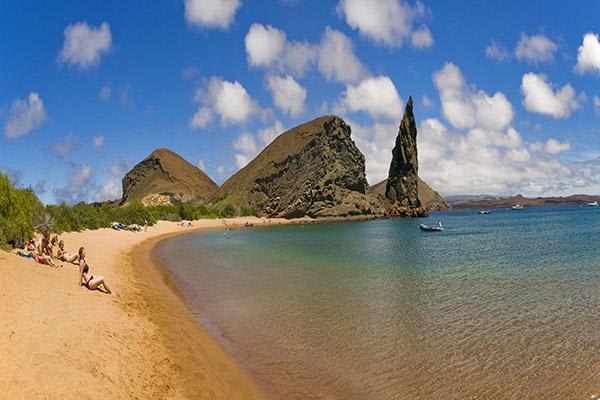
Disembarkation
AM: Visit to Mosquera Islet. Wet landing. Breakfast service. The Mosquera Islet is located between the islands of Baltra and North Seymour. It is a reef of rocks and coral (the result of an uprising) and a great white sand beach. Its narrowest width reaches about 160 meters and has an estimated length of 600 meters. In most of the perimeter there is base of lava rocks, as evidence of the lava uprising, except in the southwest side where the landing occurs. This island has one of the largest populations of sea lions. You can also observe several species of shorebirds. There have been occasional reports at this site of Orcas (Orcinus orca) feeding on sea lions. Check out and airport departure at 8:00.

Accommodations
Social Areas
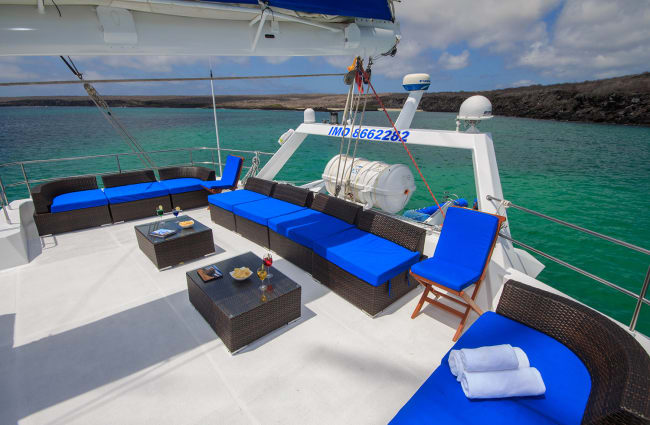

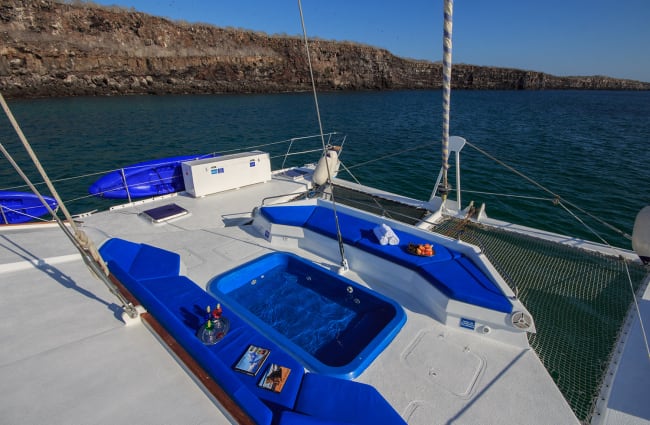
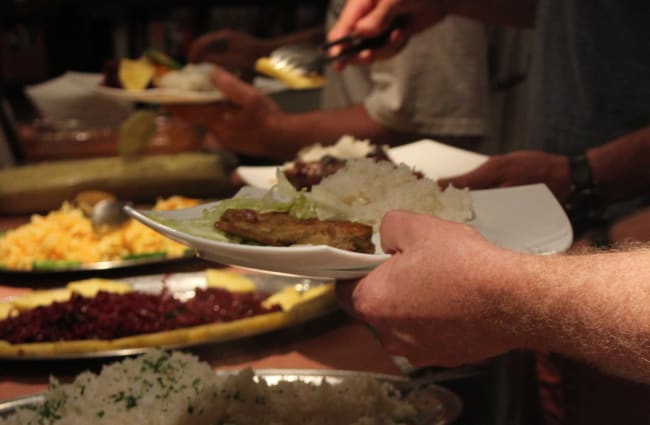
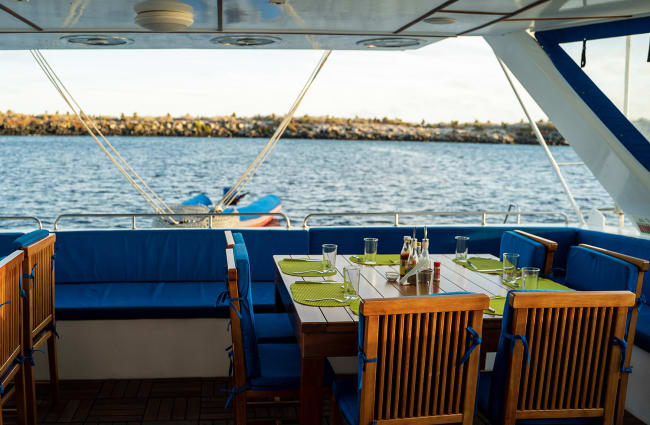
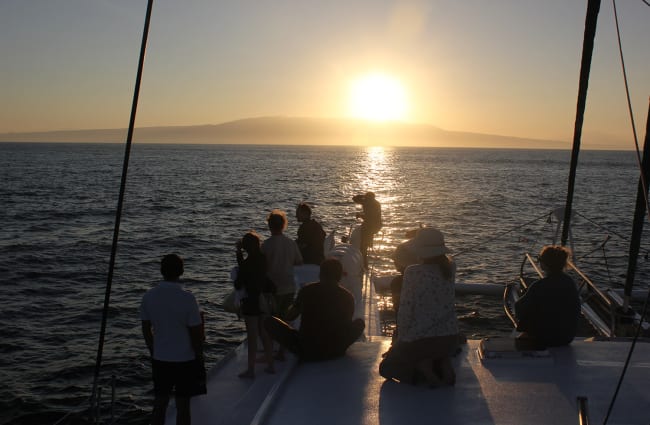
Suites & Cabins
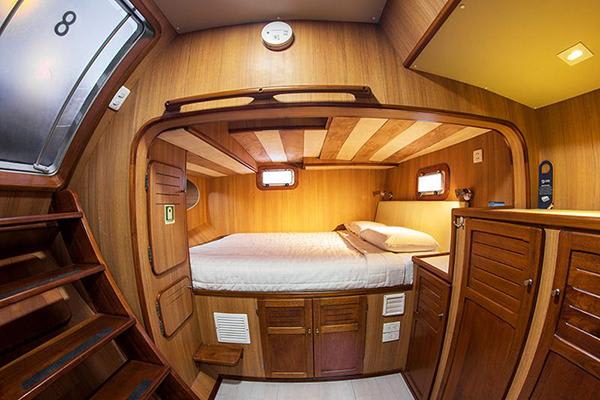
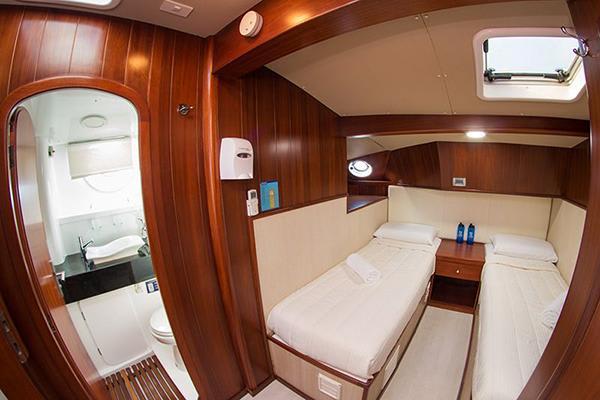
Standard Cabin
The Nemo III is home to 2 cozy standard cabins. Each dedicated double cabin has individual air conditioning, a private bathroom and reading lights. These are Cabins #7 & #8.
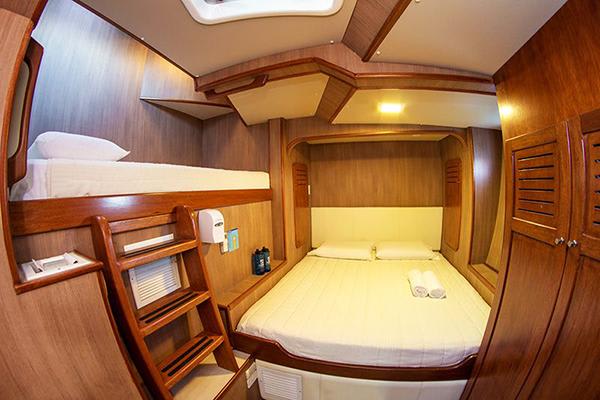
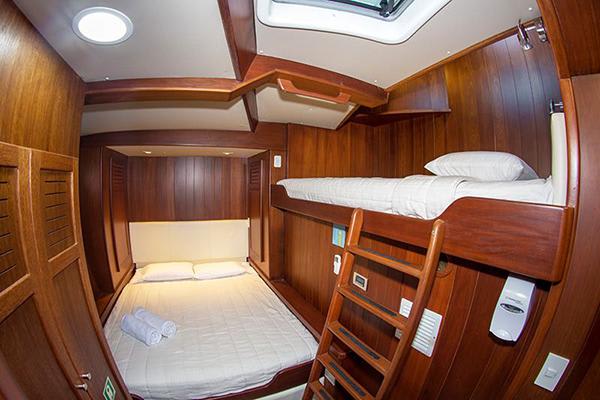


Superior Cabin
The Nemo III is home to six superior cabins. Each superior cabin has individual air conditioning, a private bathroom and reading lights. Cabins #1 & #2 have twin beds, while Cabins #3, #4 & #6 have a double bed and a single bed for a third person (the triple accommodation is available upon request) and Cabin #5 is the only one featuring a double bed.
Related Cruises
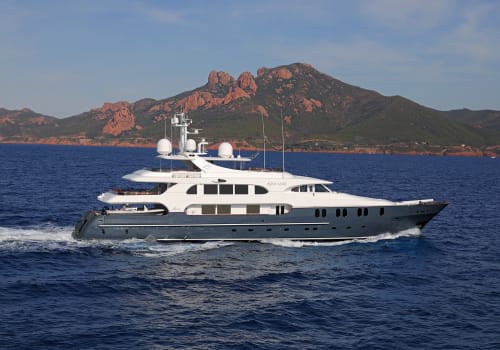
- Galapagos
- Ecuador
Aqua Mare

- Galapagos
- Ecuador
Galaxy Sirius
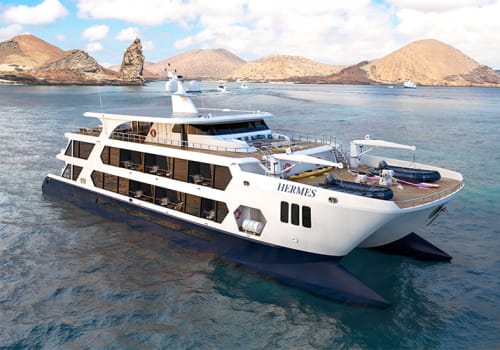
- Galapagos
- Ecuador
Hermes
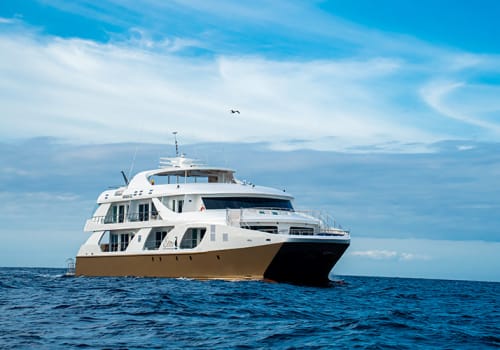
- Galapagos
- Ecuador
Elite
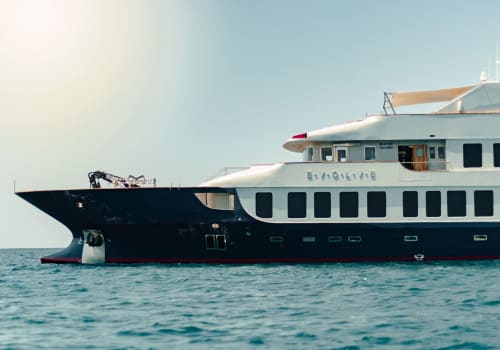
- Galapagos
- Ecuador
Origin, Theory & Evolve

- Galapagos
- Ecuador
Cormorant II
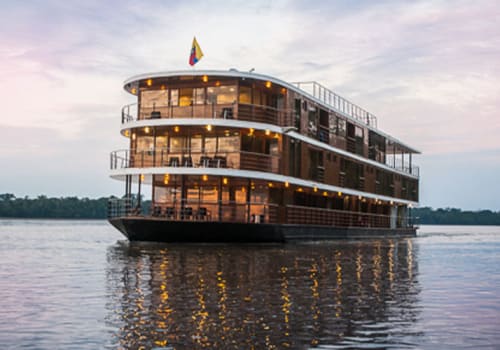
- Amazon
- Ecuador
Anakonda

- Galapagos
- Ecuador
Alya
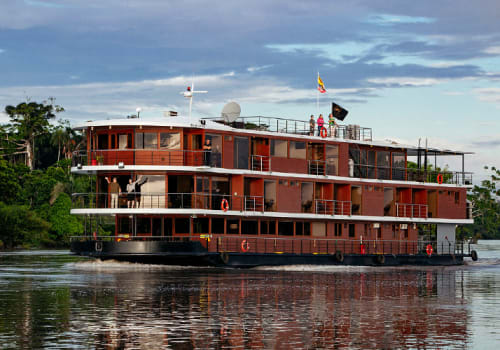
- Amazon
- Ecuador
Manatee Amazon Explorer

- Galapagos
- Ecuador
Endemic
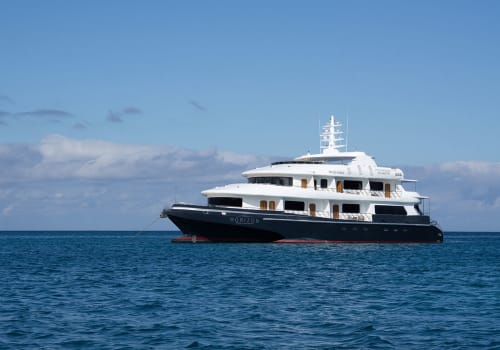
- Galapagos
- Ecuador
Galapagos Horizon
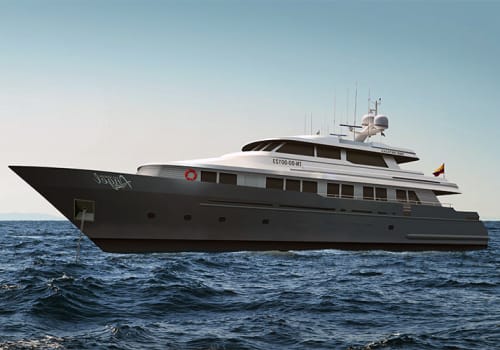
- Galapagos
- Ecuador
Galapagos Angel

- Galapagos
- Ecuador










